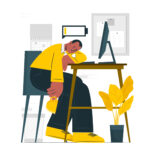
Practical Anxiety Tips You Won’t Find on Social Media
It is common knowledge that anxiety can cause symptoms such as restlessness, difficulty concentrating, fatigue and nausea, but did you know that these are actually classified as different types of anxiety and the way to deal with them is all different? Intensive Short Term Dynamic Psychotherapy (ISTDP) has an extremely meticulous theoretical framework for identifying and regulating anxiety. Understanding and having a systematic way of regulating your own anxiety according to the three-pathway theory is essential to effectively dealing with anxiety in your everyday life.

Anxiety Regulation Guidelines
We are going to talk about three separate levels or pathways of anxiety that are all felt physically within the body. Remember, we can regulate anxiety through regulating our physiology! When regulating anxiety, the golden rule is to keep breathing throughout all of the regulation techniques. This is fundamental. The other rule is that we want to regulate from Cognitive / Perceptual Disruption to Smooth Muscle, from Smooth Muscle to Striated Muscle and from Striated Muscle to relaxation with no anxiety, in this order.
1.Striated Muscle Anxiety: The Green Light for Relaxation
When we think of striated muscle anxiety, we think of anxiety that makes us feel tense in the body. This level of anxiety activates or sympathetic nervous system with the “fight or flight” response in which our heart rate and blood pressure rise in preparation for a perceived threat. This is the level of anxiety where we tend to feel jittery and filled with nervous energy. At this level of anxiety, simply pulling one’s attention to the tension and consciously relaxing the parts of the body that are tense is usually enough to regulate the anxiety back down.
Striated Muscle Anxiety Presentations
- Sighing
- hand clenching
- foot tapping
- various forms of fidgeting
- dry mouth
- jaw clenching
- biting
Striated Muscle Anxiety Regulation Techniques
As stated above, the key to all anxiety regulation is first giving attention to the physical manifestations of the anxiety and not ignoring them. At the level of striated anxiety, employing progressive muscle relaxation, in which one systematically focuses on releasing tension one body part at a time from head to toe, and meditation are effective regulation methods and enough to release the anxiety-induced tension.
In the next article, we will continue exploring the two other types of anxiety: smooth muscle and cognitive/perceptual disruption (CPD), and discuss appropriate regulation techniques for each. Stay tuned to learn more about these types of anxiety and how to effectively manage them.
2.Smooth Muscle Anxiety: The Yellow Light for Tension
Unlike striated muscle anxiety, smooth muscle anxiety tends to show up in muscles that are out of our conscious control such as the muscles responsible for contraction and expansion of the stomach, intestines and blood vessels. It is at this level of anxiety that we our parasympathetic nervous system is activated in a “rest or digest” response. At this level of anxiety, we typically have a drop in blood pressure, heart rate and muscle tension, usually feeling more fatigued or nauseous than anything else.
Smooth Muscle Anxiety Presentation
- migrainheadaches
- nausea
- burping
- diarrhea
- bladder urgency
- vomiting
- asthmatic attacks
- IBS
- gastrointestinal spasms
Smooth Muscle Anxiety Regulation Techniques
At this level of anxiety, we need to combat the drop of blood pressure and heart rate by bringing tension back into the body and raising the heart rate. This can be done through doing a 30 second to 1 minute plank on the ground, a standing yoga pose for 30 seconds to 1 minute or doing elastic band resistance exercises for 30 seconds to minute.
3.Cognitive / Perceptual Disruption: The Red Light for Sensory Shock
Cognitive / Perceptual Disruption (CPD) is where anxiety is so high that parts of our brain start to lose function. At this level of anxiety, individuals typically feel quite spaced out or dissociated, or having changes in their sensory perception in hearing or vision. It is at this level of anxiety where reality testing can go offline, an example would be in panic attacks where the individual may actually believe they are going to die from a heart attack, etc.
If you experience the following symptoms, please do NOT do meditation until the anxiety is properly regulated back down, it will only make symptoms worse.
CPD Anxiety Presentations
- blurred vision
- visual loss (temporary blindness)
- tunnel vision-hearing impairment
- temporary temporal loss
- ringing in the ears
- memory loss-mental confusion
- dizziness
- dissociation
- hallucinations
- fainting
- freeze response
CPD Anxiety Regulation Techniques
At this level of anxiety, it is extremely important to put your focus on the sensations happening in the body and notice how they shift. This may take a minute or even longer. In the cases where these symptoms persist, you can try to do a 5,4,3,2,1 Grounding in which you say out loud 5 things you can see, 4 things you can hear, 3 things you can feel, 2 things you can smell and 1 think you can taste. You can also try to dab essential oils on the palms, put the palms to the nose and take a large sniff of the scent. In the case of panic attacks, or very high unregulated anxiety, after taking ice and putting it into a large bowl of water, dunk the face in.
These techniques all force the senses back online or create a shock response in the body that helps to regulate the anxiety back down into the lower two levels.
While many people understand the typical symptoms of anxiety, they tend to not understand that anxiety takes on different forms at different levels. ISTDP’s detailed and systematic approach to understanding anxiety is extremely important for successful understanding and regulating of anxiety. Through understanding the three-pathway theory, we can actually take back control from the negative clutches anxiety has over our life and make active choices in how we deal with it.

Jennie
April 12, 2024 at 1:19 amThank you very much for your information.